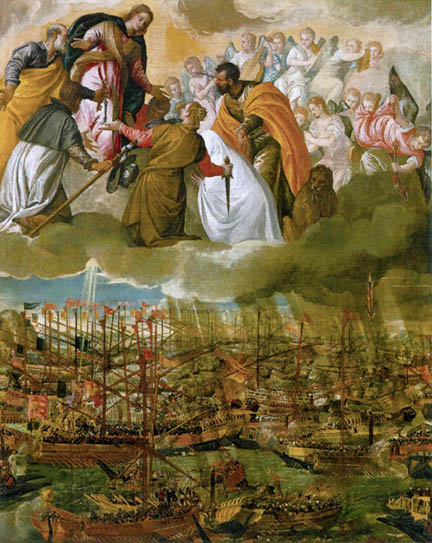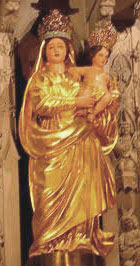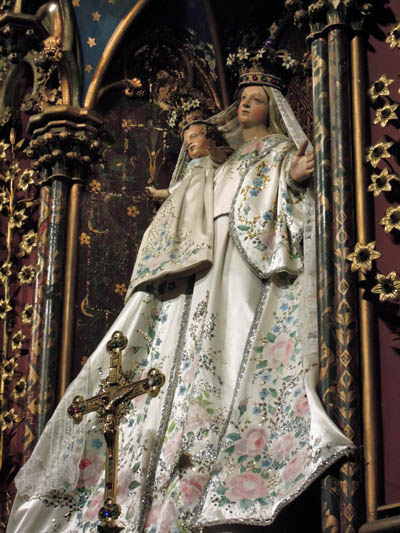

The Battle of Lepanto
Under one form or another there is no title of the Mother of God which is older or more general than that which describes Her as the Helper of the Church and the Helper of Her children. Her office in the Incarnation and Redemption was that of helper, or cooperator, with Jesus. As we have seen, the Incarnation, as God designed it, could not have been accomplished without Her help.
The name "Jesus" is in Hebrew "Yeshua" or "Jehousua" or "Josue"—which means "God saves," "God is salvation," or "God helps;" so that Mary is the Help of the Helper. The Help of Her Son, She is also the Help of His brethren—us, Her other children. The whole history of the Church, in its most critical moments, could be written from the view-point of Mary's intervention and intercession. Ever since the Council of Ephesus (431), when the declaration of Her Divine Maternity saved the doctrine of the Incarnation, She has been the Help of the Church against heresy, so that the Church has gratefully said to Her, "Thou alone has destroyed all the heresies in the whole world." In the old apocryphal book of "The Passing of Mary," which goes back to the fifth century, there is this passage: "Often here in Rome, She appears to the people who confess Her in prayer, for She has appeared here on the sea when it was troubled and raised itself and was going to destroy the ship in which they were sailing." And the sailors called out, "O Lady Mercy, Mother of God, have mercy on us, and straightway She rose upon them like the sun and delivered the ships, 92 of them, and rescued them from destruction, and none of them perished." And in like manner Mary has saved the Bark of Peter many times when it seemed threatened with destruction. Many of Her Feasts have been instituted, many of Her devotions established, or approved, and indulgenced in commemoration of the manifestation of the power of Her arm.
It is so in a particular manner with our present title, "Help of Christians." It is maintained by scholars that the title was in existence long before the Battle of Lepanto, but at any rate it is Lepanto which glorified the title as one of tremendous significance. You may recall the history. All Europe was threatened with invasion by the Muslim Turks. They occupied Lepanto (now known as the Gulf of Corinth in Greece). Catholics were panic-stricken. They surged in pilgrimages to Loreto to beg Our Lady's help. The leader of the Christian forces, Don Juan of Austria, made a vow that he, too, would go there. Our Lady listened and answered. The Holy League—a coalition of the fleets of Spain, Venice, Genoa, the Papal States, and a few others—under the command of Don Juan won a signal victory on October 7, 1571. It was the greatest defeat of the infidels at sea. It was on the occasion of that victory, in answer to the prayers of the Pope, St. Pius V, and the Rosary associations, that St. Pius introduced the title "Help of Christians" into the Litany. The next Pope, Gregory XIII, honored the day of the victory by dedicating it to Our Lady of the Rosary.
The next great manifestation of Mary's help was the victory over the Turks at Vienna won by Sobieski. We have the memory of the great soldier serving the Mass of supplication to Our Lady, his arms extended in the form of a Cross. He received Holy Communion and placed himself and his soldiers under the protection of Mary. "Now let us march on," he said, "under the powerful protection of the Mother of God."
It was another Pius, Pope Pius VII, who instituted the Feast of Our Lady Help of Christians. Napoleon had robbed the Pope of his temporal power and had driven him from Rome to Savona, where he remained a virtual prisoner for five years. His final release he attributed to the Blessed Virgin Mary, and on the way back to Rome, he visited many of Her shrines and crowned Her images. Other troubles threatened the Church when Napoleon left Elba, but the Blessed Virgin conquered again, and in thanksgiving Pope Pius instituted the Feast of Our Lady, Help of Christians, to be celebrated on May 24, the anniversary of his first return from exile. There is a lovely prayer in the Mass of the Feast: "Almighty and merciful God, Who for the defense of the Christian people hast wonderfully established in the Most Blessed Virgin Mary a perpetual help, grant that, fortified by such aid, we who are struggling in life may be able to obtain over the evil enemy victory in death." For us the Church appoints all these Feasts as an inspiration to our own sanctification, urging upon us to go to Mary for that purpose.
Another aspect of the devotion to Our Lady as Helper is that of the devotion to Our Mother of Perpetual Help. It was occasioned by the picture of that name. Some even attributed the picture to St. Luke, on account of its Byzantine style, though others considered it to belong to the 13th century. The picture represents Mary and Her Child while St. Michael and St. Gabriel offer the instruments of the Passion.
The story of the picture is an interesting one. There was a Christian merchant who lived in Crete at the end of the 15th century. Afraid of invasion by the Turks, he and some friends set sail for Rome, bringing the picture with them. A terrible storm threatened to destroy the ship, but all prayed before the miraculous picture and thus were saved. The merchant, when dying in Rome, made a will leaving the picture to one of the Roman Churches. It was given to the Augustinian Church of St. Matthew, where it was exposed for veneration, being borne there solemnly, in 1499, amid crowds of people. It was called "Our Lady of St. Matthew." For 300 years the picture was honored and was the occasion of innumerable favors and many miracles, until in 1812 the French army occupied Rome. At that time the picture disappeared when the Church of St. Matthew was destroyed. No trace of it was found for 40 years. Then one day it was discovered in an oratory of the Augustinians, and Pope Pius IX, who as a boy had prayed before it, ordered it to be given to the Church of St. Alphonsus built on the site of the Church of St. Matthew. On April 26, 1866, it was brought to the Church. Pius IX, who had great devotion to the picture and who was one of the first to visit it in its new home, had it solemnly crowned on June 23, 1867. In 1876 he granted a proper Mass and Office to the Feast of Our Lady of Perpetual Help, as the picture was now called, and enriched with many indulgences the archconfraternity of the same name. Since then many churches and altars have been dedicated to Our Lady under that title, and with the same image.
When the Irish went into battle in the middle of the 17th century, their blue standards had a picture of Our Lady, upon whom they relied for victory, while the soldiers wore their Rosaries around their necks. Owen Roe O'Neill urged them to trust in the Blessed Virgin Mary, and gave them as their watch-word Sancta Maria. Many of the cities of Ireland called themselves "Our Lady's City," and on more than one occasion found Her to be their help.
 We have examples in our own country of Mary's help. During the War of 1812 when New Orleans was threatened by the British, the Ursuline Sisters made a vow to Our Lady of Prompt Succor (image at left) to have a Mass of Thanksgiving sung every year if the city were spared by an American victory. Just at Holy Communion time, a messenger arrived to tell of the American victory in the Battle of New Orleans, January 8, 1815. General Jackson himself acknowledged the Divine intervention and paid a visit to the Sisters to thank them for their prayers.
We have examples in our own country of Mary's help. During the War of 1812 when New Orleans was threatened by the British, the Ursuline Sisters made a vow to Our Lady of Prompt Succor (image at left) to have a Mass of Thanksgiving sung every year if the city were spared by an American victory. Just at Holy Communion time, a messenger arrived to tell of the American victory in the Battle of New Orleans, January 8, 1815. General Jackson himself acknowledged the Divine intervention and paid a visit to the Sisters to thank them for their prayers.
 It was Our Lady of Bon Secours (image at right) who saved Montreal, when the ship-fever threatened to destroy the whole population.
It was Our Lady of Bon Secours (image at right) who saved Montreal, when the ship-fever threatened to destroy the whole population.
These are but a few instances of the aid given by Our Lady, Help of Christians. There is not one of the devotions to Her—the Scapulars, the Ave Maria, the Salve Regina, etc.—that has not a thousand stories to tell of Her aid in time of distress. Thus the Church, in the Mass of the Seven Dolors, applies to Her the words of the Book of Judith (Ch. 13): "The Lord hath blessed Thee by His power because by Thee He hath brought our enemies to naught. Blessed art Thou, O Daughter, by the Lord, the Most High God, above all women upon the earth. Blessed be the Lord, Who made Heaven and earth, because He hath so magnified Thy name this day, that Thy praise shall not depart out of the mouth of men, who shall be mindful of the power of the Lord forever: for that Thou hast not spared Thy life by reason of the distress and tribulation of Thy people, but hast prevented our ruin in the presence of God."
But Mary's help is not confined to the public needs of the Church, not to the great emergencies that threaten to hamper the work of Her Divine Son. She is ready to help every one of us individually. She is not merely the Help of Christianity, She is the Help of Christians. So the Church turns every commemoration of Her aid into a lesson for us. In the Mass for the Feast of Our Lady of Ransom, for instance, in honor of the foundation of the Order of Our Lady of Mercy for the Redemption of Captives, She prays: "O God, Who by means of the most glorious Mother of Thy Son, wast pleased to give new offspring to Thy Church for the deliverance of Christ’s faithful from the power of the heathen, grant, we beseech Thee, that we who lovingly honor Her as the Foundress of so great a work may by Her merits and intercession be ourselves delivered from all sin and from the bondage of the evil one."
St. Thomas when dying said that he had never asked anything of God through the intercession of Mary without obtaining it. A truth that we, too, have experienced. The Help of Christians—what an inspiration to us to know that She is always waiting, the first aid to our poor injured souls, to bring them to life, sweetness and hope.
Contact us: smr@salvemariaregina.info
Visit also: www.marienfried.com